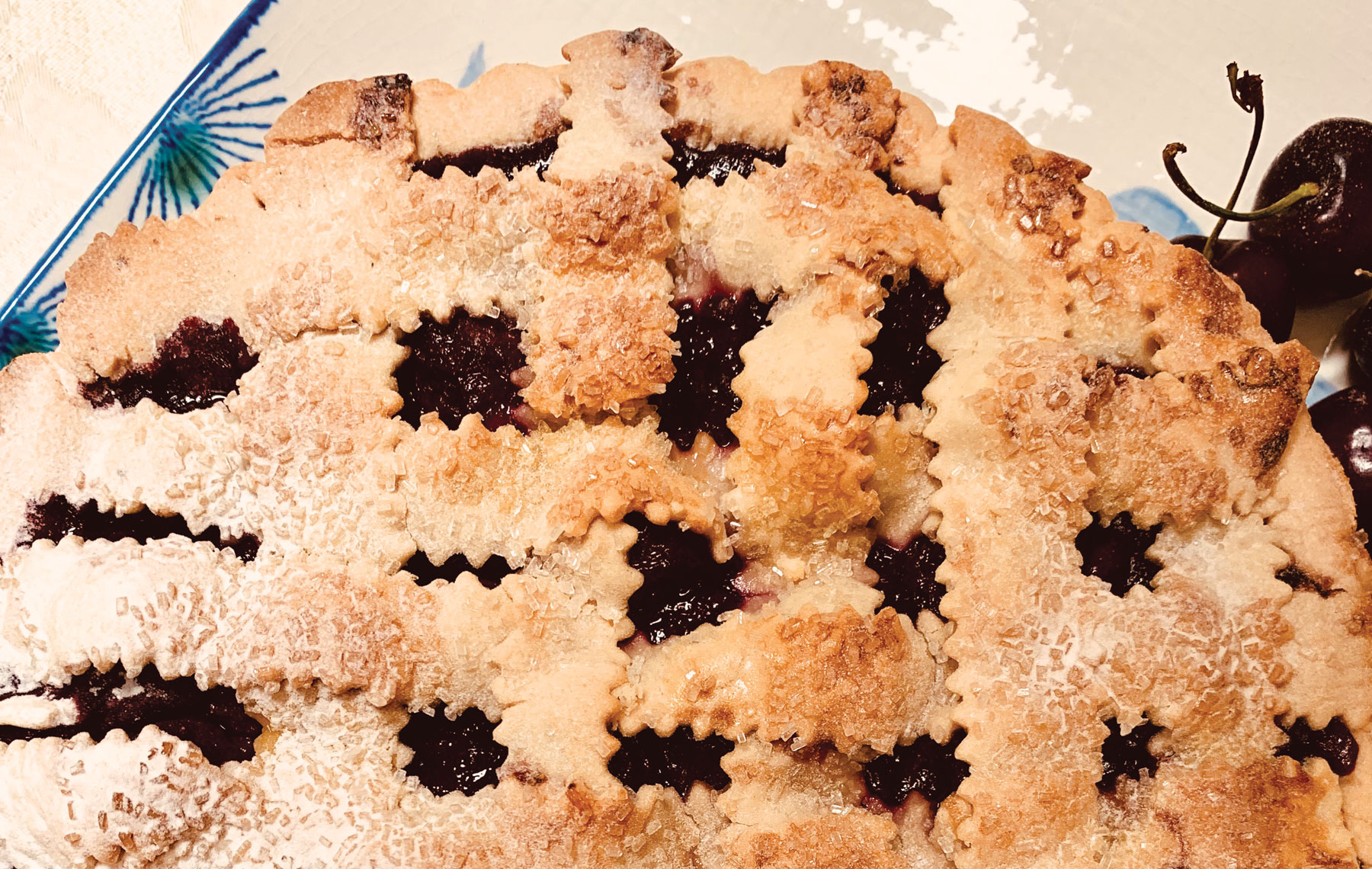
I can hardly think of anything more gratifying or life-affirming than picking summer fruits in an orchard and then going home to make pies out of them. In Israel, in the very short cherry season — late June to mid-July — the bright clear mornings of the Golan Heights towns and kibbutzim draw hundreds of families for the “pick and pay” farming activities.
On most summer days, there are already lines of people by 9 a.m. waiting for a ticket to enter the orchards where the first order of business is a quick lesson in the basics of picking (pick cherries with the stems on).From there, you are handed a basket or a bucket and told about two types of cherries, light pink or dark red, and you try not to eat them all while comparing their sweetness (surprisingly light pinks are sweeter), hoping you can get enough in your basket to bake with. Fat chance — it’s practically a rite of passage to eat so many cherries that you are barely able to look at the fruit on the drive home, and sometimes even for several days after.
Children playing in the shade of the trees quickly tire of gorging on fruit while their parents and grandparents pick as if possessed, until hands and tongues are stained cherry red and all their worries have been chased away. Perhaps it’s the fleeting nature of cherries with their slightly almond-flavored undertones that make them my favorite summer fruit. Or maybe it’s simply the way the bright orbs grow and hang in pairs, as if made for dangling on children’s ears — the perfect double-sided fruit earring or Carmen Miranda-style hat decoration.
The price of admission for these “pick your own” farms always include all the fruit you can eat and then a separate payment for whatever you carry home, weighed on those confusing rustic metal scales, the kind that employ heavy weights for balancing and seemed impossibly mysterious in youth, and still manage to produce a visceral reaction in adulthood. Since I come from a long line of fruit pickers and professional eaters, I have plenty of memories of these orchards, of strawberry and raspberry patches where my aunts would take my cousins and me and would always make the same joke: Surely when the poor farmers thought up this business model, they didn’t know our family would be coming, like locusts descending upon a field — they won’t be making profits on us. Looking back, I’m certain every family thinks this.
Although Israel didn’t have much of a pie culture when I was a child, our Bulgarian family has a tradition of creating a liqueur from sour cherries called vishnyek and, of course, there was always plenty of cakes and strudels to use up the abundance of Israel’s extraordinary fruit. To this day, my Aunt Erna, now 94, never shows up at any of our family events without a bottle or two of her homemade brew, ironic since there is hardly a person who drinks alcohol in my family. Yet each one of us has a decanter of it in our pantry or sitting on a counter. It’s great to use as an addition to a cake or pie as it has a sweet, concentrated cherry flavor and the alcohol taste bakes out when it’s cooked.
Since cherries are such a memory food for my Bulgarian father, I decided to make him a cherry pie for his birthday, which falls smack dab in the middle of the cherry season. Although my father would be perfectly happy eating his way through a pile of cherries, or any fruit for that matter, unadulterated by sugar or pastry, the father of a pastry chef is all but required to forgo the pleasures of eating fruit “au naturel” on his birthday.
Although I didn’t have access to freshly picked cherries from a farm, I convinced my father to take me to the store to buy some. There we sat in their kitchen, my mother peeling apples for an apple crumble pie, my father cracking us up DJing the event from his iPad — “Alexa, sing me happy birthday” — while I stood at the counter stemming and pitting with my rarely used gadget, trying hard to contain the staining juices for the benefit of my mother’s sanity in her pristine white-tiled kitchen.
“This cherry pie, in all its bursting juicy glory, is the closest you can come to eating a plate of warm fruit, reduced to its jammy essence by sunshine and then captured in a pastry blanket.”
My parents, who have not been privy to much of my professional cooking career since it’s taken place in Uganda, so far away from them, marveled at the speed of my pitting and slicing, while I, egged on by their oohing and aahing, showed off trying my best to make them proud with my lattice-weaving skills. And even though the 100-degree humidity of a Virginia summer afternoon is probably not ideal for turning on the oven, or rolling out pie dough, it may never be possible to beat the pride and satisfaction I felt later that night. Having pulled the glorious pies out of the oven hours earlier, giving them plenty of time to cool on the counter to reabsorb the juices, I served my parents two perfect slices alongside large frozen scoops of the requisite throwback Cool Whip, the still marvelous nondairy topping invented in the ’60s when my parents were far younger than I am today.
Yes, this cherry pie, in all its bursting juicy glory, is the closest you can come to eating a plate of warm fruit, reduced to its jammy essence by sunshine and then captured in a pastry blanket, but the only word that suffices for all the moments that led up to its creation is priceless.
PRICELESS CHERRY PIE
Find my perfectly flakey pie crust recipe online at Yamit’s Table.
Or use 2 prepared pie doughs
1 egg white, beaten, for brushing on bottom crust
For the filling:
6 to 7 cups fresh cherries (any type; I use Bing), washed, stemmed and pitted
1/2 cup sugar
3 tablespoons fresh lemon juice
2 tablespoons cherry liqueur (optional)
1 teaspoon pure vanilla essence
1/2 teaspoon pure almond extract
1/4 teaspoon salt
1/4 cup plus 2 tablespoons cornstarch or potato starch (or ¼ cup tapioca flour)
For assembling pie:
2 tablespoons cold butter, diced
1 egg yolk plus 1 tablespoon cream, for egg wash on crust
1 tablespoon coarse sugar, for sprinkling
Start by making pie dough and keep top and bottom dough in the refrigerator while you make the filling.
For the filling, cook cherries with all ingredients except cornstarch, until fruit releases juices and cherries begin breaking down. Remove 1/2 cup of cherry juice and mix with starch until it forms a slurry and then add back to pot cooking until juice boils, thickens and sticks to fruit. Remove pie filling to a flat tray in an even layer and store in fridge for 30 minutes until completely cool.
To assemble pie, prick bottom crust with a fork, then brush beaten egg white on and let dry. Pour in cold pie filling and dot with butter pieces. Place top dough on filling and crimp both doughs together, making sure to cut a steam hole into the top crust for venting. Brush entire crust with egg yolk/cream mixture and sprinkle with coarse sugar. Freeze uncooked pie for 20 minutes and preheat oven to 425 F.
Place pie on baking sheet (to catch seeping juices) on rack in bottom third of oven for 15 minutes. Then reduce heat to 350 F and bake for another 45 minutes or until juices are bubbling and top of pie is golden brown and fully cooked. Place foil rim on crust if it gets too dark before pie is fully baked.
Yamit Behar Wood, an Israeli-American food and travel writer, is the executive chef at the U.S. Embassy in Kampala, Uganda, and founder of the New York Kitchen Catering Co.























 More news and opinions than at a Shabbat dinner, right in your inbox.
More news and opinions than at a Shabbat dinner, right in your inbox.